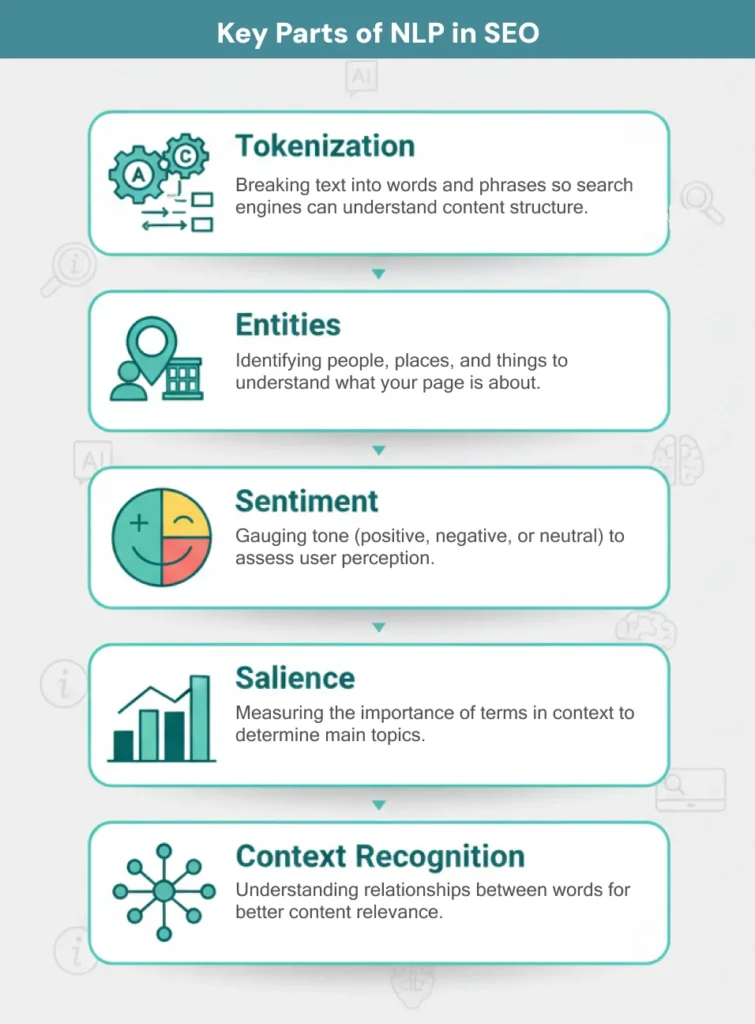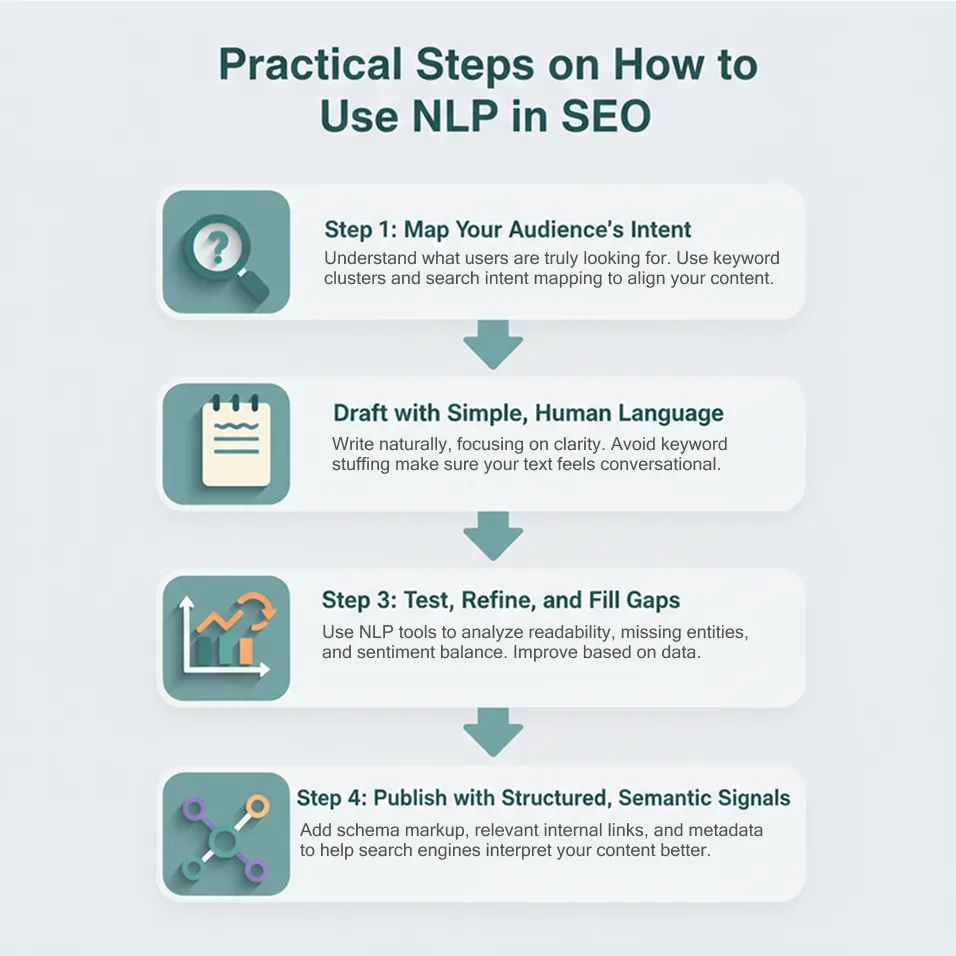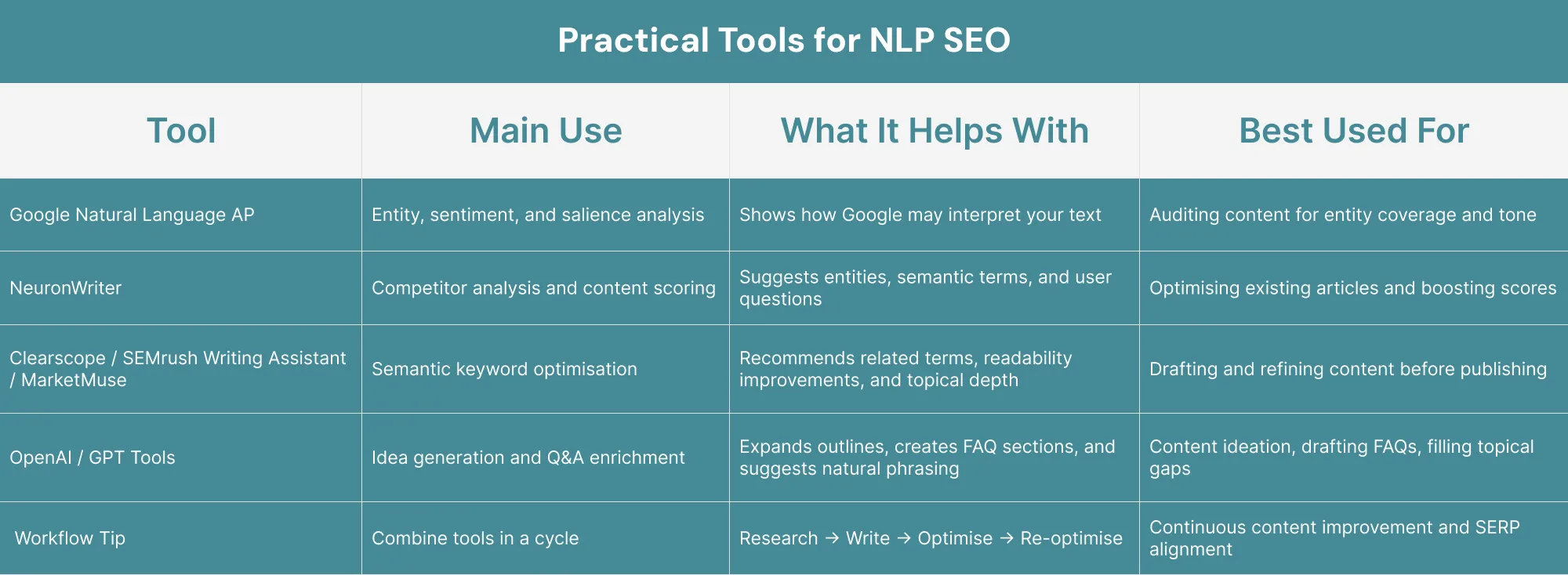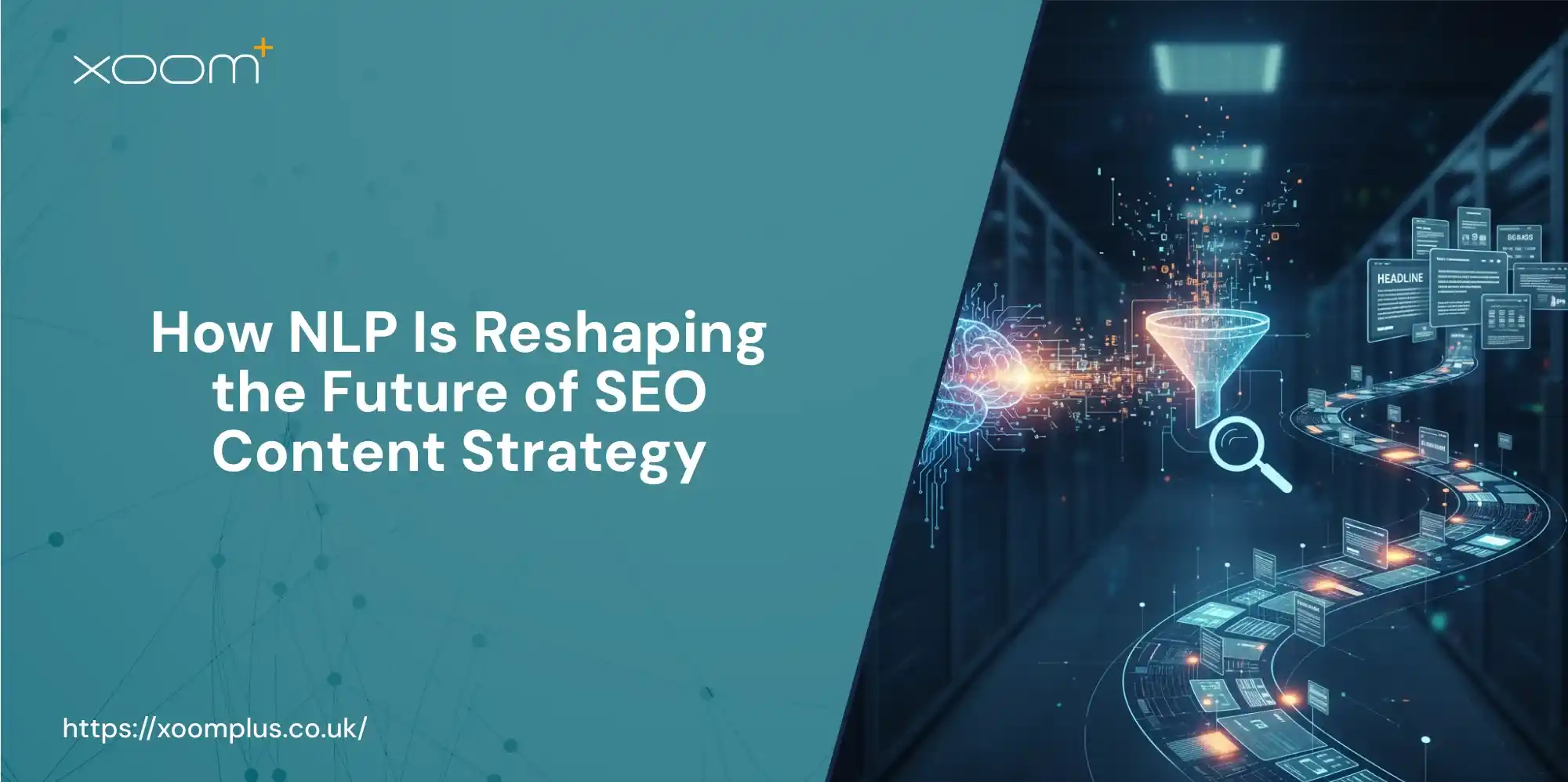- November 3, 2025
- Categories: Digital Marketing
How NLP Is Reshaping the Future of SEO Content Strategy
Traditionally, whenever someone used the word SEO, one would think about stuffing keywords as much as possible. But times have changed. The rise of Natural Language Processing or NLP, has made Google far smarter than it was. Put simply, NLP for SEO is a form of artificial intelligence that helps Google understand language the way humans do. With NLP, Google extracts and analyses the information. This helps the search engine look at the true picture, understanding the meaning in a broader context. Google NLP for SEO has proven to be a game-changer in recent years. Genuine content is being rewarded and spammy discarded. Follow along with us in this blog, and you will know everything about NLP in SEO.
What Is NLP in SEO?
NLP or Natural Language Processing is a form of artificial intelligence that teaches computers to understand language the way humans do. Think of how you would read a sentence. You won’t just see individual words. You will understand the meaning, the context and the emotion. With NLP in SEO, computers are able to do the same thing.Key Parts of NLP in SEO
Here are the key parts of NLP for SEO:Tokenization:
It is like breaking sentences into puzzle pieces. Text is split into individual words and phrases by the computer to understand the words better.Entities:
This term of NLP SEO refers to all the important words you mention in your content. They can be names of brands like Nike or iPhone, and NLP recognises them as specific entities, not just generic words.Sentiment:
As the name suggests, this part is about understanding emotions. NLP in SEO can tell a search engine if a particular review is negative, positive or neutral. Through this, search engines understand the tone of your content.Salience:
This is about figuring out the most important part of your content. This way, Google figures out the main parts of your content.Context Recognition:
This gives Google the context of a word or phrase. Suppose you have written “apple”. This part would help the search engine understand whether you mean the fruit or the tech giant.
The Big Shift: From Keywords to Intent
The old way of SEO was just stuffing keywords in the content, but now it’s different. Let’s take a look at how SEO has evolved over the years till NLP:Early Era of SEO
Earlier, SEO used to be simple, but it made the content pretty robotic. If you wanted your content to rank for ‘best pizza restaurant’, you had to repeat the words as many times as you could. Sometimes the keywords were even hidden in the background in white text. Eventually, Google started fighting back. With the algorithm updates of Panda (2011) and Penguin (2012), content quality began getting rewarded. Now, keyword density was not as important; still, search engines mostly looked for keyword matches, just in a more sophisticated way.The BERT Revolution
IN 2019, Google introduced BERT (Bidirectional Encoder Representations from Transformers). This is what brought NLP in SEO for the first time, proving to be a game-changer. With this, Google began understanding nuance, context and subtext in the content. The relation of words with each other, the interpretation of prepositions, and conversational language patterns all started being understood by Google. Also, it started understanding questions.The Conversational AI Boom
2021 marked the beginning of voice search with Alexa, Siri, and Google Assistant. People started to search in the way they talked, i.e., in casual language. This helped NLP for SEO even more as it enhanced its capacity to decipher natural language, context, and conversational intent.How NLP Is Reshaping SEO Content Strategy
1. Search Intent Comes First
It is absolutely essential to understand what your audience really wants before you start typing your content. It is called search intent, and it forms the foundation of NLP for SEO. There are four main types of search intent, and they are as follows:2. Informational intent:
These kinds of queries arise when people want to learn something. For instance, searches such as “how to tie a tie,” “what is diabetes,” etc., mean someone is looking for learning more about these topics. They are looking for tutorials and explanations that can help them figure out their issue.3. Navigational Intent:
You may search with this intent when you want to reach a certain website. For example, when you search “Facebook login,” “Amazon customer service,” “YouTube”, you know what page you want to reach.4. Transactional Intent:
These kinds of search questions indicate people are ready to buy something. A few examples of such intent would be “buy iPhone 15,” “order pizza near me,” “book hotel room”5. Commercial Intent:
This is sort of a hybrid intent where people do want to make a purchase, but they are comparing their options for now. Some examples of this intent are “best laptops 2024,” “iPhone vs Samsung,” and “cheap car insurance”.How to Figure Out Search Intent
The best way to figure out search intent is to simply type your keywords on Google. This is called SERP analysis. If you get lots of how-to articles, tutorials, etc., then it is informational; if you see product pages and offers, it is transactional. If you see comparison articles, people are in research mode.2. Entities and Salience
Google doesn’t just read keywords. It understands entities (people, places, products, ideas) and how important they are in your text (salience). This comes from the Google Knowledge Graph, which is a vast database of facts about real-world entities like people, places and things. For NLP for SEO, it is important to cover a topic with the addition of all of the relevant entities. For instance, if you are writing on ‘Apple iPhone’, make sure that you mention “iOS,” “apps,” or “smartphone.” You can add entities naturally into:- Headings (clear topic signals)
- Metadata (titles, descriptions)
- Schema markup (structured data for search engines)
- Body text (natural flow, not keyword stuffing)
3. Sentiment and Tone in SEO
NLP for SEO can detect sentiment in your content, and spoiler alert, it is a ranking factor. Basically, NLP in SEO checks your words, phrases and even emotions to figure out the emotional tone of your content. This helps it to guess if your content has a positive sentiment, a negative one or just a neutral tone. Most top-ranking pages have positive sentiment. This is because people prefer a positive tone and helpful content. However, this does not mean that all content needs to be the same. It is important to match the sentiment to search intent.Matching Sentiment to Search Intent
Here are a few examples to teach you how you can figure out the tone in which you have to write based on search intent:- For someone searching for diabetes, you will put up content that is positive but realistic and reassuring. It should read something like, ‘Managing diabetes is hard, but with appropriate care, you can lead a healthy life.
- For product reviews, the tone needs to be neutral and helpful. For instance, “This laptop is good value for money, but battery life can be a bit better.
- In problem-solving searches, you need to be empathetic but offer solutions as well. Here is an example: “Having your car break down in the morning sucks. Here are a few steps that you can take to make it a bit better.”
4. Structuring Content for NLP in SEO
NLP for SEO also involves structuring your content in the best way possible. You have to organise like a roadmap so that your audience, as well as the search engine, can understand your message better. Use main headings and subheadings for this. Also, make your content a good mix of paragraphs and bullets to break monotony. A great way to structure the content well is to use questions + answers format. This helps your content rank in featured snippets as well as AI sections. For instance, to write the benefits of green tea, make the heading “What Are the Benefits of Drinking Green Tea?”.Using Specific Entities
To optimise your content for NLP for SEO, always be specific about your entities. You have to be very clear about what you mean. For instance, always write, “Paris, France” instead of just “Paris”. This clears all disambiguations, and the search engine connects your content to the right audience.5. Covering the Full Search Journey
When you search for something, you don’t always want an immediate answer and stop. You want details, follow-up questions, and pictorial explanations. For a smart NLP for SEO, you should incorporate all of this in your content. Here are some things that you can do:Think Beyond the Main Question
- When to plant tomatoes
- What soil is best for tomatoes
- How often to water tomatoes
- Common tomato growing problems
- How long until tomatoes are ready to harvest
Use Google’s Own Research Tools
Create Comprehensive FAQs
Create In-Depth Content Instead of Thin Pages
6. Linking and Context Building
Links aren’t just for SEO juice anymore. Now they help NLP for SEO build up an understanding of your content and its connection to the wider context. This creates a phenomenon called topical hierarchy in which links on your page tell the search engines how your content relates to each other. Here is an example of good internal linking. Your main topic page is “Complete Guide to Healthy Eating”. To help NLP for SEO, you link subtopic pages such as “Best Foods for Weight Loss” or “Meal Planning for Beginners” with the descriptive anchor text.External Links Build Trust and Context
Linking to high-quality, authoritative websites helps with NLP in SEO. Basically, these links signal that you have researched the topic well and are providing in-depth information. Here are some good external linking practices:- Cite recent studies when making health claims
- Reference official sources for statistics
- Link to the authority sites for additional information
Make Your Anchor Text Match Intent
Anchor text means the words on which you attach the link. For better NLP for SEO, this text should not be generic like “Click here,” “Read more,” “This article”, etc. It should clearly describe what the users will find when they click on the link. A few good anchor text examples are as follows:- Learn how to meal prep for beginners
- See the latest nutrition research
- Find healthy breakfast recipes
Practical Tools for NLP SEO
Here are some tools that can help you in NLP for SEO:
Practical Steps on How to Use NLP in SEO
Step 1: Map Your Audience’s Intent
Putting theory into action need not be hard. First, start with intent mapping. List the main questions your audience has. Then, for each question, gather related keywords, synonyms and entities. Use a mix of tools from Google Suggest to NLP APIs. Build a content brief that includes primary terms and at least ten related entities. Next, embed NLP for SEO guidance into your editorial workflows.Step 2: Draft with Simple, Human Language
Next, draft your content in clear, simple language. Aim for short sentences and avoid jargon. When you explain a concept, answer it fully before moving on. If you say what NLP in SEO is, make sure you cover its role in entity recognition parsing and sentiment analysis. That gives the reader a sense of completion. While you write, remember that NLP for SEO is about clarity more than density.Write for Clarity and Depth
Answer every sub‑question within your main topic. For instance, if you mention entity recognition, show a brief real‑world case study or example. Such depth positions you as an expert and satisfies detailed search queries without feeling overloaded or scattered. This will be understood and supported by NLP in SEO.Step 3: Test, Refine, and Fill Gaps
After you write, run your draft through an NLP tool. Testing with NLP for SEO tools reveals hidden gaps. For example, you might use Google’s natural language API or an open source library to extract top entities and sentiment scores. Compare those results to briefs from top-ranking pages. That gap analysis shows you what to add. According to the Semrush State of Content Marketing report, 76 per cent of marketers plan to increase spending on NLP-driven content tools in 2025. That surge in investment underscores how vital these steps are becoming.Step 4: Publish with Structured, Semantic Signals
Finally, publish with clear headings and meta text that mirror your intent signals. Use schema to mark up FAQs or product details so engines can display rich answers. Schema and markup amplify NLP for SEO signals to search engines. Add internal links to related pages so you build a strong site topic map. By following these steps, you apply NLP in SEO to meet both user and engine needs.
Future of NLP for SEO
So, what is next for NLP for SEO? With the technology growing by leaps and bounds, advanced workings will be upon us sooner than we realise. Here are some of the trends to look forward to:AI Search Is Taking Over
Google’s Search Generative Experience (SGE) and Bing’s Copilot have begun a new era of browsing. Users no longer view links. They have conversations with these tools and generate answers on the spot. This means that AI models are now being trained on your content, and summaries of different content are being used for these AI snippets. Getting featured in these snippets is as important as ranking at number 1. This means that you have to create content that is easy for AI to understand and quote.Voice Search and Conversational AI Are Exploding
People using their voice search devices have become as common as using search boxes. “Hey Google,” “Alexa,” and “Siri” are pushing NLP for SEO to understand the speech patterns better than ever. Voice search is different from normal search due to its being more conversational and using complete sentences. It also helps NLP for SEO to understand contextual cues better. Now that people expect natural responses like Generative AI, these advances in NLP can help search engines achieve it as well.Multi-Modal Search Is Coming
The future isn’t just about text anymore. The search is expanding to images, videos and even combinations of different media. For instance, you take a picture of a plant and ask the search engine if it is safe for plants. This means that your content needs to go beyond words. You need to add images, infographics and whatever else you can to keep up with these multi-modal searches.Conclusion
In the last few years, NLP for SEO has grown far beyond matching words. We at XoomPlus recognize this. It is now the backbone of modern search and content strategy. To achieve success, it is pertinent to focus on user intent, audience sentiment and guiding users to their full journey. Understanding and embracing all these new trends will keep you ahead of the curve and help your content rise to meet the needs of every search. Contact XoomPlus to start your journey of using NLP for SEO today.Ready to transform your content strategy with Xoomplus?
Visit Xoomplus today to unlock the full power of NLP-driven SEO and stay ahead of the competition.
Faqs
Natural Language Processing (NLP) in SEO uses machine‑learning models to understand meaning, intent, entities, and sentiment in text. By focusing on context rather than exact keyword matches, NLP helps search engines deliver more relevant results and rewards content that reads naturally and answers user queries in full.
NLP guides you to cover related concepts, synonyms, and user questions around a topic, often called “intent mapping.” This depth ensures your pages serve multiple user needs at once, increase engagement, and earn richer search features like featured snippets and knowledge panels.
Popular options include Google’s Natural Language API for entity and sentiment analysis, spaCy or NLTK in Python for custom parsing, and content‑optimization platforms like Clearscope or MarketMuse that surface key terms and gaps based on NLP insights.
Track metrics such as click‑through rate (CTR), average time on page, and rank improvements for your target topics and related terms. Look for lifts in rich‑feature appearances (e.g., snippets, People Also Ask) and improved engagement signals, which indicate your content meets both user and algorithmic expectations.
Use clear, descriptive headings and schema markup to highlight entities. Write in natural, conversational language with synonyms and related terms. Link related pages into topic clusters and run drafts through an NLP tool to identify and fill any gaps.
Yes. Google employs models like BERT and MUM to understand query context, sentiment, and entities, enabling more accurate, intent‑based results.
Apply sentiment analysis to customer feedback, use topic modeling to spot emerging trends, personalize offers based on language patterns, and power chatbots for natural, responsive customer interactions.

